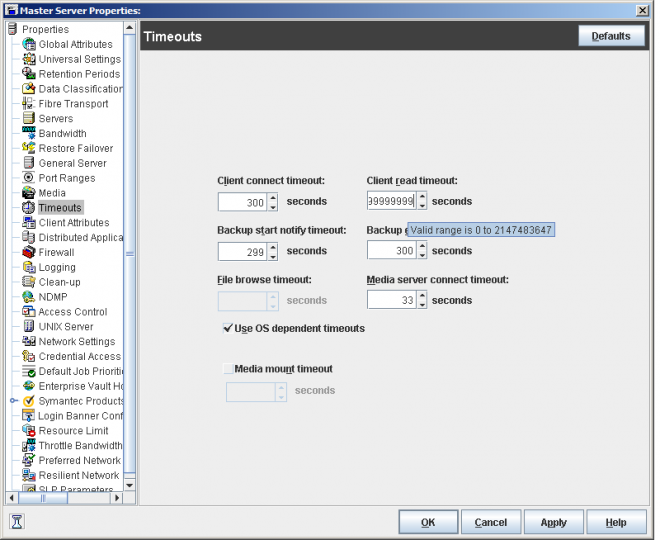- VOX
- Data Protection
- NetBackup
- is there any maximum limit for Client_read_timeout
- Subscribe to RSS Feed
- Mark Topic as New
- Mark Topic as Read
- Float this Topic for Current User
- Bookmark
- Subscribe
- Mute
- Printer Friendly Page
- Mark as New
- Bookmark
- Subscribe
- Mute
- Subscribe to RSS Feed
- Permalink
- Report Inappropriate Content
08-06-2015 07:49 AM
Hi,we have an issue where the restore is being failed as there are file with large size(approx 15GB) but the writing speed is only 5MB/sec. So we suggested to increase the value of client_read_timeout to 14400 as the values 1440,3600,7200 didn't give succsessful backups.The restore is successful for the value 14400.Could you please let us know if there is any maximum limit for the client_read_timeout value?
Solved! Go to Solution.
Accepted Solutions
- Mark as New
- Bookmark
- Subscribe
- Mute
- Subscribe to RSS Feed
- Permalink
- Report Inappropriate Content
08-06-2015 09:55 AM
I opened up my (7.6.1) admin console and started typing nines and this popped up:

So I believe you can technically set that timeout for about 6.8 years, if you desire.
I'm not sure this is something you'd WANT to do in practice, however. ;)
- Mark as New
- Bookmark
- Subscribe
- Mute
- Subscribe to RSS Feed
- Permalink
- Report Inappropriate Content
08-06-2015 10:54 PM
Changing client_read_timeout will not resolve your backup performance/speed issue.
Client_read_timeout is meant for resolving timeou issue, such as error codes 40, 41, 13, 24, 69 you can consider changing it. And while there is a max value allowed, I normally won't go > 14400 sec, because if that high value cannot solve your timeout issue, your backup is just taking too long to wait.
Anyway, back to backup speed, check your job details for "waited for xxxx buffer" message and go through this technote to identify where the slowness come from:
http://www.symantec.com/docs/TECH18422
- Mark as New
- Bookmark
- Subscribe
- Mute
- Subscribe to RSS Feed
- Permalink
- Report Inappropriate Content
08-06-2015 09:55 AM
I opened up my (7.6.1) admin console and started typing nines and this popped up:

So I believe you can technically set that timeout for about 6.8 years, if you desire.
I'm not sure this is something you'd WANT to do in practice, however. ;)
- Mark as New
- Bookmark
- Subscribe
- Mute
- Subscribe to RSS Feed
- Permalink
- Report Inappropriate Content
08-06-2015 10:54 PM
Changing client_read_timeout will not resolve your backup performance/speed issue.
Client_read_timeout is meant for resolving timeou issue, such as error codes 40, 41, 13, 24, 69 you can consider changing it. And while there is a max value allowed, I normally won't go > 14400 sec, because if that high value cannot solve your timeout issue, your backup is just taking too long to wait.
Anyway, back to backup speed, check your job details for "waited for xxxx buffer" message and go through this technote to identify where the slowness come from:
http://www.symantec.com/docs/TECH18422
- Mark as New
- Bookmark
- Subscribe
- Mute
- Subscribe to RSS Feed
- Permalink
- Report Inappropriate Content
08-06-2015 11:23 PM
For restore it some times makes sense to to have a bigger CLIENT_READ_TIMEOUT, for example for big SQL databases as the SQL Server "formats" the database files before the actually data transfer starts unless the file initialization is disabled.
What speed did the backup of the file run with ? Restore is almost always slower as it a write rather than read operation.
Have you checked what the different hardware components limits are ? NetBackup speeds will never be better than the slowest component in the chain.
I would start with checking what speed the disk system can actually write with as writing usually is the bottleneck.
- Mark as New
- Bookmark
- Subscribe
- Mute
- Subscribe to RSS Feed
- Permalink
- Report Inappropriate Content
08-07-2015 06:19 AM
Thank you all for your responses. All the responses helped me .
Sowjanya
- Maximum VMware machine size for NetBackup VMware backup? in NetBackup
- Netbackup jobs waiting for a tape drive but there are tape drives available in NetBackup
- Veritas NetBackup Most Common Status Codes in NetBackup
- the current master server is limited to a maximum of 256 drives in NetBackup
- Maximum concurrent write drives set to 8 but only uses 5. in NetBackup

